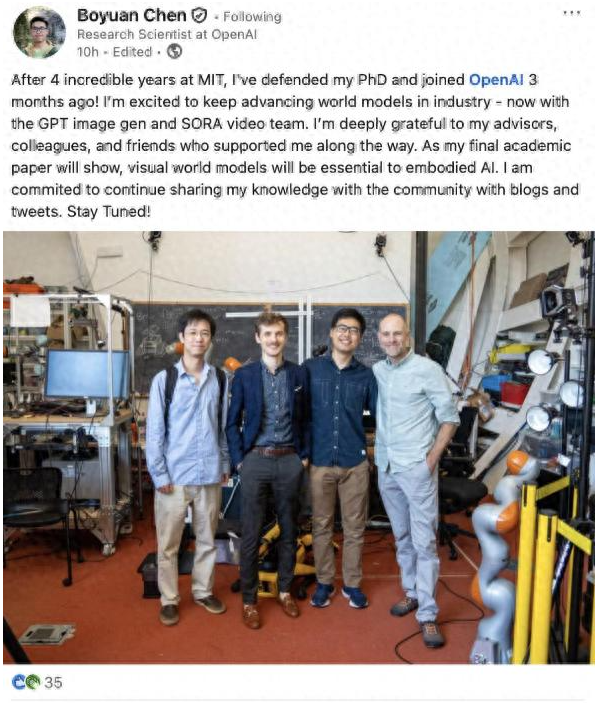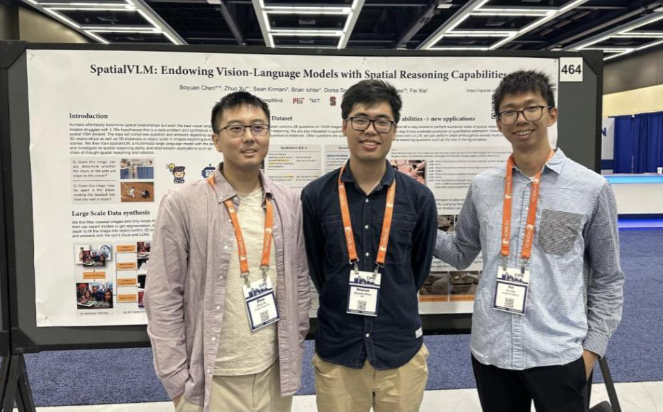The AI community has been buzzing with news: Bo Yuan Chen, a Chinese researcher at OpenAI, has just completed his PhD defense at MIT.
This young scholar, who secured a doctorate from one of the world’s top institutions in under four years, is also one of five core members of the GPT image generation team and a contributor to the explosive Sora video model.
Even more impressively, he is spearheading research on “world models”—a line of work that could fundamentally reshape the trajectory of artificial general intelligence (AGI).
From not knowing Python in high school to standing at the cutting edge of AI today, Chen has emerged as a cross-disciplinary genius—bridging computer science, mathematics, and philosophy—who is quietly redefining how AI understands the world.

Struck by Deep Learning as a Teenager
Chen’s journey with AI began during a high school summer camp, where he first encountered Dr. Fei Xia, who introduced him to the wonders of deep learning. Though he had no programming background at the time, the encounter planted a seed of curiosity that grew into a lifelong pursuit.
Chen later studied computer science and mathematics at UC Berkeley, while also spending a year on philosophy coursework. This interdisciplinary training became a defining advantage in his research career.
During his undergraduate years, he founded a robotics education company, designing both hardware and software for competition kits. The experience taught him a crucial lesson: technology must be practical and applicable, not just theoretical.
The real turning point came during his internship at DeepMind in 2023, where he contributed to training multimodal large language models. His work on synthetic data pipelines later became part of Gemini 2.0. More importantly, he reconnected with Dr. Fei Xia, who invited him to join new research projects.

Building the “Brain Map” for AI
Chen’s most significant research focus is on “world models”—frameworks that give AI a cognitive map of reality. Unlike traditional systems that react step by step, world models allow AI to simulate outcomes in advance, similar to how humans mentally rehearse actions before execution.
In his doctoral work, Chen emphasized the importance of visual world models for embodied intelligence—enabling robots to navigate and understand the physical world.
As part of the GPT image generation team, he integrated these concepts into generative systems, ensuring that AI-created visuals followed realistic physical laws. This approach proved pivotal in OpenAI’s Sora video model, where object motion and lighting appear more natural and grounded.
OpenAI has since announced the formation of a humanoid robotics algorithms team, explicitly seeking researchers to push AGI-level intelligence in real-world environments—a perfect match for Chen’s expertise.
His prior project, NLMap, already demonstrated practical applications: robots could understand natural language instructions and autonomously plan actions. For instance, when told to “bring me the red cup on the table,” the system could scan its surroundings, locate the target, and map out the optimal path to retrieve it.

A Philosopher-Coder Bridging Disciplines
Chen’s interdisciplinary foundation makes him stand out in today’s highly specialized AI landscape. His background in philosophy enables him to ask not only how to implement AI but also why.
In his writings, he has argued that embodied intelligence will be one of the most transformative technologies of the next century. But he stresses the need for patient, long-term investment rather than chasing short-lived hype. Quoting his mentor, he often reminds peers: “Research can be results-driven, but it should never be driven by viral videos.”
This mindset shapes his technical work as well. In SpatialVLM, he incorporated insights from cognitive science, focusing on how spatial reasoning enhances AI’s ability to interpret human intent. Peers often note that his work is “both deeply technical and philosophically ambitious.”
His entrepreneurial background also grounds his research in practicality. Collaborating with companies like BoostRun, he developed interfaces that support diverse hardware platforms, accelerating the commercial deployment of his systems.

A Long-Termist in the AI Era
Chen’s path challenges the stereotype of the “effortless genius.” His first year at MIT was marked by struggles and zero publications, yet he resisted the temptation to chase trendy research areas. Instead, he doubled down on the relatively obscure world model approach—a decision that has since paid off.
With the rise of GPT and Sora, the importance of world models has been validated. Both academia and industry now recognize that teaching AI to understand the rules of reality is more critical than simply feeding it more data.
From OpenAI’s robotics team to Tesla’s Optimus project and Google’s robotics initiatives, the race is on for supremacy in embodied AI. Chen, having invested years in this space, is already among the frontrunners.

For everyday observers, his journey offers a lesson in persistence: from a teenager awed by deep learning, to an entrepreneur experimenting with real-world applications, to a PhD researcher shaping AI’s future. His steady focus on fundamentals over fads underscores a key truth—lasting breakthroughs demand patience and conviction.
Looking ahead, with OpenAI doubling down on robotics, Chen’s research may soon find even broader applications. He has openly stated that he is willing to dedicate his life to advancing general-purpose robots. Given his trajectory so far, it may not be unrealistic to imagine him helping unlock the next frontier of AI.
References
- MIT AI Lab dissertation defense reports (2025)
- DeepMind research contributions to Gemini 2.0 (2023)
- OpenAI recruitment announcements (2025)



